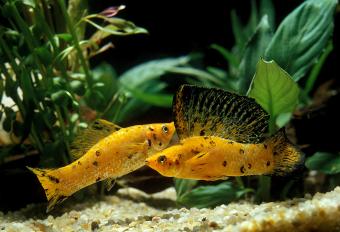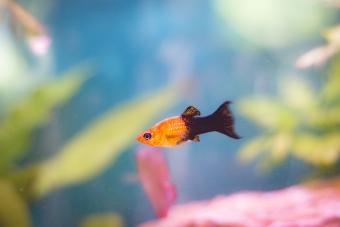
Goldfish may be one of the most popular pet fish, but what do you feed goldfish? As omnivores, goldfish will eat anything you feed them, although that doesn't mean you should. Understanding what goldfish can eat is essential so you can provide your pets with proper nutrition and help them live long healthy lives.
What Do Goldfish Eat?
What can you feed goldfish? Feeding goldfish the right food is one of the most important aspects of caring for these pets. Goldfish are opportunistic feeders that won't stop feeding as long as food is available. Due to this behavior, they can suffer from digestive problems and even death if overfed. The more goldfish are fed, the more waste they will produce, which can lead to excess toxins in the tank that can slowly poison the fish or contribute to other goldfish diseases. Understanding what goldfish eat and how to feed them properly is critical for a healthy pet.
Fish Food for Goldfish
Aquarium fish lead a less active life than wild fish and need much less food to stay well fed and healthy. Specially formulated goldfish food is recommended for these fish, as it has a lower concentration of protein - which goldfish have trouble digesting - and more carbohydrates than standard fish food. Goldfish food is available in both flake and pellet form, and offering both types of food can give fish variety for their feeding preferences. Flakes float and pellets sink, which gives the fish opportunities to feed at different levels in the tank.
Recommended Goldfish Food
Some top commercially prepared goldfish foods are:
- TetraFin Balanced Diet Goldfish Flakes Food is designed to keep the tank or pond water clean and bring out the brilliant color of the fish.
- Fluval Bug Bites Pellets for Goldfish is another highly rated goldfish food product. The primary ingredient is black soldier fly larvae, and it has Omega 3 and 6 fatty acids.
- Omega One Goldfish Small Sinking Pellets is made to avoid clouding the water and reduce waste.
What to Feed Goldfish Besides Fish Food?
In addition to goldfish food, a variety of unique treats can be offered occasionally to goldfish to supplement their basic diet. With these foods, offer only tiny amounts - about what a fish can eat within about one to two minutes and no more. Only feed these treats every two days or so. Goldfish can eat:
- Shelled peas (skins removed)
- Bloodworms (live, frozen, or freeze-dried)
- Brine shrimp (live, frozen, or freeze-dried)
- Ghost shrimp (live, frozen, or freeze-dried)
- Daphnia (live, frozen, or freeze-dried)
- Mealworms (live, frozen, or freeze-dried)
- Crickets (live, frozen, or freeze-dried)
- Leafy greens (lettuce, spinach, kale, chard, etc.)
- Cooked rice
- Boiled or microwaved diced broccoli
- Boiled or microwaved diced corn
- Boiled or microwaved, peeled, and diced zucchini
- Boiled or microwaved, peeled, and diced carrots
- Grapes (skinned and chopped)
- Boiled or microwaved cucumber slices
- Orange slices
- Watermelon slices
- Fish algae wafers
Non-Fish Foods to Avoid
Bread is commonly thrown to goldfish, particularly fish kept in ponds. You should never feed bread to a fish as it can swell inside their intestines and cause constipation and even death.
Occasional Treats for Goldfish

Each of these extra foods can be beneficial for goldfish, but only in small amounts and as an occasional treat. It is not advisable to feed goldfish nothing but these treats because they will not receive the rounded nutrition they need; instead, the proper diet is to feed them goldfish food daily and add these treats one to two times per week for variety. The treats should be left in the tank only for several minutes, and any remaining food should be removed after that time to prevent overfeeding, rotting, and soiling the tank.
Goldfish Feeding Tips
Once you can answer the question of what do goldfish eat, you will be able to feed your goldfish a varied, healthy diet. To keep the fish happily fed:
- Offer goldfish food at the same times each day. The fish will learn to recognize who is feeding them and will come to the surface to be fed. With patience, they can even learn to take food off your fingertips.
- Feed the goldfish two to three times a day with tiny amounts for up to about one minute. You will need to learn to gauge how much food to add in each one-minute section, as you want the fish to eat whatever is there and not leave waste.
- If the tank is getting dirty very quickly, the fish are being overfed and are producing too much waste. Reduce the amount of food slowly to acclimate the fish to their new diet, and supplement goldfish food with occasional treats.
- Only feed treats one to two times per week and try a variety of different treats to accommodate the preferences of different fish. Like humans, goldfish can have different tastes and feeding preferences.
- Remove uneaten food, both fish food and treats, 15 minutes after feeding the fish. Uneaten food can rot and will be unhealthy for the fish, and it also contributes to a dirty tank and extra toxins. Removing uneaten food will also help regulate your pets' diet so they do not overfeed.
- Cleaning the tank after a feeding is a good idea as you can remove uneaten food from your most recent feeding.
Can Goldfish Eat Betta Food?
Some pet owners with both goldfish and bettas wonder if the food can be used for both. While goldfish can eat betta food occasionally (once a week or less), their nutritional needs differ, so it shouldn't be a regular dietary swap. Food made for bettas and other similar fish has more protein and fewer carbohydrates, so long-term feeding of betta food to your goldfish will negatively impact their health.
Can Goldfish Eat Turtle Food?
Some goldfish owners keep their fish in tanks or ponds with aquatic turtles. Since goldfish will attempt to eat whatever is put in the tank, they are likely to eat food made for turtles. While this will not harm the fish, separate feedings are best, as the healthiest diet for the fish is one made specifically for their species.
What Do Goldfish Eat in the Wild?
Wild goldfish eat a variety of foods, including aquatic plants, algae, aquatic insects, and small crustaceans. Since wild fish have to evade predators, battle currents, and adapt to a constantly changing environment, the goldfish's natural habit of always foraging is helpful to provide enough energy for an active lifestyle.
About Goldfish
The goldfish (Carassius auratus) is one of the most common freshwater aquarium fish in the world, and its beautiful color is often considered symbolic of good luck and prosperity. This makes it a popular pet worldwide. The goldfish is actually a type of domesticated carp and has been associated with humans for centuries. Today there are dozens of specially bred goldfish breeds available. The fin sizes and shapes, overall color, eye shape, and fish size all vary depending on the breed. These are very hardy fish and can be easy for pet owners to care for even if they have never had fish before.
Benefits of a Nutritious Goldfish Diet
By knowing what goldfish eat, pet owners can help their fish have an attractive, nutritious diet that suits their aquarium or pond lifestyle. With careful feeding and attentive care, a goldfish can live a long life and be a fun pet for many years.







